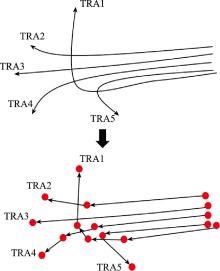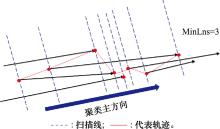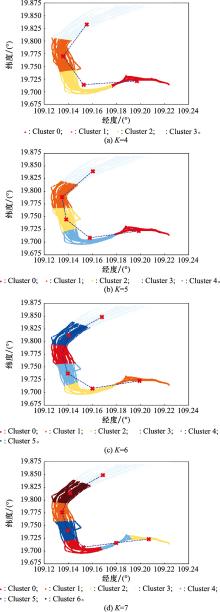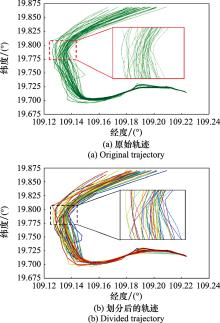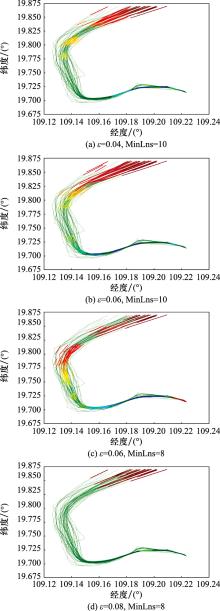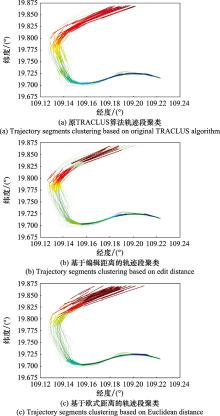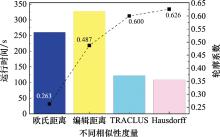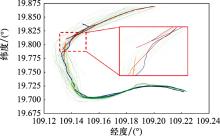| 1 |
DEVELOPMENT U N . Review of maritime transport 2021[M]. Geneva: United Nations Publications, 2021.
|
| 2 |
肖潇. 基于AIS信息的船舶轨迹聚类模型研究[D]. 厦门: 集美大学, 2015.
|
|
XIAO X. Study on ship's trajectory clustering model based on AIS data[D]. Xiamen: Jimei University, 2015.
|
| 3 |
刘敦伟. 基于AIS数据的船舶航线挖掘[D]. 大连: 大连海事大学, 2017.
|
|
LIU D W. The vessels route mining based on AIS data[D]. Dalian: Dalian Maritime University, 2017.
|
| 4 |
ZHOU Y , DAAMEN W , VELLINGA T , et al. Ship classification based on ship behavior clustering from AIS data[J]. Ocean Engineering, 2019, 175, 176- 187.
doi: 10.1016/j.oceaneng.2019.02.005
|
| 5 |
LIU C , LIU J X , ZHOU X , et al. AIS data-driven approach to estimate navigable capacity of busy waterways focusing on ships entering and leaving port[J]. Ocean Engineering, 2020, 218, 108215.
doi: 10.1016/j.oceaneng.2020.108215
|
| 6 |
孙明悦, 马胤垚. 基于Spark并行化的改进K-Means轨迹聚类的方法[J]. 数字技术与应用, 2023, 41 (10): 112- 114.
|
|
SUN M Y , MA Y Y . Method of trajectory clustering based on improved K-Means algorithm with Spark parallelization[J]. Digital Technology & Application, 2023, 41 (10): 112- 114.
|
| 7 |
张喜梅, 解滨, 徐童童, 等. 基于反向K近邻和密度峰值初始化的加权K-Means聚类入侵检测算法[J]. 南京理工大学学报, 2023, 47 (1): 56- 65.
|
|
ZHANG X M , XIE B , XU T T , et al. Intrusion detection algorithm based on weighted K-Means clustering with reverse K-Nearest neighbor and density peak initialization[J]. Journal of Nanjing University of Science and Technology, 2023, 47 (1): 56- 65.
|
| 8 |
ZHEN R , YONGXING J , HU Q , et al. Maritime anomaly detection within coastal waters based on vessel trajectory clustering and naive Bayes classifier[J]. Journal of Navigation, 2017, 70 (3): 648- 670.
doi: 10.1017/S0373463316000850
|
| 9 |
邱文轩, 许志远, 翟泽宇, 等. 基于改进DBSCAN算法的船舶轨迹聚类与可视化应用[J]. 中国水运, 2023, 8, 59- 61.
|
|
QIU W X , XU Z Y , ZHAI Z Y , et al. Application of vessel trajectory clustering and visualization based on improved DBSCAN algorithm[J]. China Water Transport, 2023, 8, 59- 61.
|
| 10 |
刘钰, 彭鹏菲. 基于改进DBSCAN的船舶轨迹聚类方法研究[J]. 舰船电子工程, 2022, 42 (12): 57- 63.
|
|
LIU Y , PENG P F . Research on clustering method of vessel trajectory based on improved DBSCAN[J]. Ship Electronic Engineering, 2022, 42 (12): 57- 63.
|
| 11 |
韩田宇. 基于HDBSCAN的船舶轨迹聚类方法[J]. 科学技术创新, 2022, 19, 164- 167.
|
|
HAN T Y . Ship trajectory clustering method based on HDBSCAN[J]. Scientific and Technological Innovation, 2022, 19, 164- 167.
|
| 12 |
宋鹏. 基于C-OPTICS算法的船舶轨迹聚类与应用[D]. 大连: 大连海事大学, 2017.
|
|
SONG P. In partial fulfillment of the requirement for the degree of master of engineering[D]. Dalian: Dalian Maritime University, 2017.
|
| 13 |
PALLOTTA G, VESPE M, BRYAN K. Traffic route extraction and anomaly detection from AIS data[C]//Proc. of the Cost Move Workshop on Moving Objects at Sea, 2013.
|
| 14 |
江玉玲, 熊振南, 唐基宏. 基于轨迹段DBSCAN的船舶轨迹聚类算法[J]. 中国航海, 2019, 42 (3): 1- 5.
|
|
JIANG Y L , XIONG Z N , TANG J H . Ship trajectory clustering algorithm based on DBSCAN[J]. Navigation of China, 2019, 42 (3): 1- 5.
|
| 15 |
苏俊杰, 兰培真. 考虑多维特征的船舶轨迹分层聚类算法[J]. 上海海事大学学报, 2022, 43 (4): 30- 36.
|
|
SU J J , LAN P Z . Hierarchical clustering algorithm for ship trajectories considering multi-dimensional features[J]. Journal of Shanghai Maritime University, 2022, 43 (4): 30- 36.
|
| 16 |
陈星佑. 基于分层聚类及LSTM模型的共享单车流量预测研究[D]. 上海: 上海财经大学, 2020.
|
|
CHEN X Y. Research on bike sharing traffic forecasting based on hierarchical clustering and LSTM model[D]. Shanghai: Shanghai University of Finance and Economics, 2020.
|
| 17 |
孙宗元, 方守恩. 高速公路出入口运动车辆轨迹分层聚类算法[J]. 吉林大学学报(工学版), 2017, 47 (6): 1696- 1702.
|
|
SUN Z Y , FANG S E . Hierarchical clustering algorithm of moving vehicle trajectories in entrances and exits freeway[J]. Journal of Jilin University (Engineering and Technology Edition), 2017, 47 (6): 1696- 1702.
|
| 18 |
王浩成, 向隆刚, 关雪峰, 等. 基于出租车上下客数据流与分布式多阶段网格聚类的城市热点区域实时探测方法[J]. 地球信息科学学报, 2023, 25 (7): 1514- 1530.
|
|
WANG H C , XIANG L G , GUAN X F , et al. Urban hotspot detection from the data stream of Taxi pick-up and drop-off based on distributed multistage grid clustering[J]. Journal of Geo-information Science, 2023, 25 (7): 1514- 1530.
|
| 19 |
孙子超. 基于位置的大数据网格聚类统计发布与隐私保护方法[D]. 兰州: 兰州理工大学, 2023.
|
|
SUN Z C. Location-based big data grid clustering statistics publishing and privacy protection model[D]. Lanzhou: Lanzhou University of Technology, 2023.
|
| 20 |
唐春华. 基于轨迹聚类和KDE的船舶轨迹异常实时检测[D]. 上海: 上海海事大学, 2022.
|
|
TANG C H. Real-time detection of abnormal ship trajectory based on trajectory clustering and KDE[D]. Shanghai: Shanghai Maritime University, 2022.
|
| 21 |
张韫博. 基于AIS数据的船舶轨迹异常检测[D]. 大连: 大连海事大学, 2021.
|
|
ZHANG Y B. Vessel trajectory anomaly detection based on AIS data[D]. Dalian: Dalian Maritime University, 2021.
|
| 22 |
王森杰, 何正伟. 分层建模的船舶轨迹快速聚类算法[J]. 武汉理工大学学报(交通科学与工程版), 2021, 45 (3): 596- 601.
|
|
WANG S J , HE Z W . Fast clustering algorithm of ship trajectory based on hierarchical modeling[J]. Journal of Wuhan University of Technology (Transportation Science & Engineering), 2021, 45 (3): 596- 601.
|
| 23 |
冷泳林, 鲁富宇. 一种基于时序的层次轨迹聚类算法[J]. 重庆理工大学学报(自然科学), 2017, 31 (3): 123-127, 157.
|
|
LENG Y L , LU F Y . A hierarchical trajectory clustering algorithm based on time series[J]. Journal of Chongqing University of Technology (Natural Science), 2017, 31 (3): 123-127, 157.
|
| 24 |
ILANGO M R , MOHAN V . A survey of grid based clustering algorithms[J]. International Journal of Engineering Science and Technology, 2010, 2 (8): 3441- 3446.
|
| 25 |
姬强, 孙艳丰, 胡永利, 等. 深度聚类算法研究综述[J]. 北京工业大学学报, 2021, 47 (8): 912- 924.
|
|
JI Q , SUN Y F , HU Y L , et al. Review of clustering with deep learning[J]. Journal of Beijing University of Technology, 2021, 47 (8): 912- 924.
|
| 26 |
MIN E , GUO X F , LIU Q , et al. A survey of clustering with deep learning: from the perspective of network architecture[J]. IEEE Access, 2018, 6, 39501- 39514.
|
| 27 |
LI X C, ZHAO K Q, CONG G, et al. Deep representation learning for trajectory similarity computation[C]//Proc. of the IEEE 34th International Conference on Data Engineering, 2018: 617-628.
|
| 28 |
FANG Z Q, DU Y T, CHEN L, et al. E2DTC: an end to end deep trajectory clustering framework via self-training[C]//Proc. of the IEEE 37th International Conference on Data Engineering, 2021: 696-707.
|
| 29 |
YAO D, ZHANG C, ZHU Z H, et al. Trajectory clustering via deep representation learning[C]//Proc. of the International Joint Conference on Neural Networks, 2017: 3880-3887.
|
| 30 |
LEE J G, HAN J, WHANG K Y. Trajectory clustering: a partition-and-group framework[C]//Proc. of the ACM SIGMOD International Conference on Management of Data, 2007.
|
| 31 |
王明涛. 移动对象轨道聚类算法的研究[D]. 南京: 南京航空航天大学, 2010.
|
|
WANG M T. Research on trajectory clustering algorithms of moving objects[D]. Nanjing: Nanjing University of Aeronautics and Astronautics, 2010.
|
